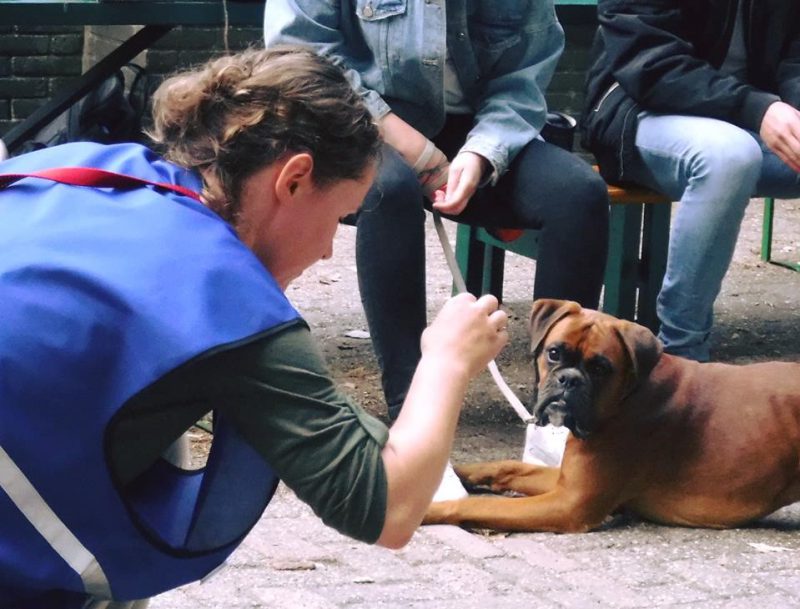[illustration credits at the end of the post]
I wish there was a better word to describe what we do. ‘Dog training’ certainly isn’t it.
Let me start by telling you a little secret: I am allergic to registrations that start with “I want my dog to do as he is told” and “I want my dog to obey my commands”.

Sit, SIT, SIIIIIIIT!
This typical scenario is symptomatic of this obsession with having the dog ‘obey’ no matter what.
We sometimes have dogs who can’t cope with the frustration of not being able to play with the other dogs in class. Their coping strategy (from screaming to biting the lead) drives their *owners mad. Before you know it, you have a frustrated, wound up, hyperstimulated pup biting the lead and a frustrated, wound up, hyperstimulated owner shouting “Sit” the whole time.
Luckily our behaviour coaches help put things back on track (by increasing the distance to the other dogs, adding a visual barrier, and giving the dog something else to do) but every time we hear that dreaded “Siiiiiit!”, we die a little bit inside.
The dog-human relationship
Words like ‘Dog training’ seem to come with expectations that the dog must ‘just’ do as he’s told. This disciplinarian approach is horrifying to us. It treats dogs like prisoners of war. Owners insisting on controlling the dog’s every move often get there because they have heard of the dominance theory. Thankfully, less and less qualified dog professionals rely on it to help you raise a well-behaved dog.
To us, a healthy dog-person relationship is more like a healthy parent-child relationship:
- No force or intimidation at either end
- Mutual tolerance, trust and respect
- Letting the dogs be themselves (when that is practical and socially acceptable) and keeping them out of trouble when that is not possible.

As the ‘parent’, you are in charge of:
- Raising them as kindly, fairly, intelligently and patiently as you can;
- Taking care of their needs, meaning keeping them safe, healthy, fed AND HAPPY; and
- Making the big decisions.
In short, you’re the grown-up. Sure that means you’re the ‘leader’ if you want to think of it in those terms, but being the grown-up also means doing your best not to be angry, insecure and impatient with your dog’s disobedience.
Is the dog unwilling or unable to listen?
Can you tell the difference between a dog who misbehaves “on purpose” and a dog can’t help it? Is the disobedient dog really being cheeky, defying your authority, flicking you the finger? More often than not, the dog is actually not. Instead:
- He is either unable to cope with the situation emotionally (e.g. too stressed, scared, overwhelmed, etc.); and/or
- He has not practiced enough at that level of difficulty.

The beauty of it is: once you know that the dog is not coping, you can make the situation easier for the dog and try again. Result? The dog “performs.” Isn’t that what you wanted in the first place?
“Just” stop the inconvenient dog behaviour problem
Our clients have similar expectations of ‘results’ in behaviour therapy. Who doesn’t want a quick fix, right? Just ‘make’ him stop with the annoying behaviour.
This comes in conflict with our priorities: finding out why the dog is misbehaving and alleviate the suffering that is often at the root of the misbehaviour.
Typical of this confusion, is the owner of a dog dog who screams in distress when home alone. How many owners don’t then simply main slap a shock collar on the dog to stop the barking? Is the dog better able to cope with being home alone? Highly doubtful. But he, at least the neighbours aren’t complaining anymore.
Dog training: focusing on the process, not the results
I am being a terrible salesperson here, I realise. “You don’t want results? Well then am going to go find a trainer who does” – and off to the nearest shock jockey they go.
Don’t get us wrong. We do want results. We just want to get ethically and intelligently, and taking into account what the dog is capable of giving.
We want to give you (and the dog!) the skills to cope with the problem situation, rather than pretend the dog is OK with it. A dog who sits because he is scared of punishment isn’t less over-excited at the idea of the doorbell. Now he’s over-excited and scared.
Sure it can often take a little bit longer, but the results are more profound.
Think of it like a navigation system. If I use the navvie, I can have gone to the same address a million and a half times and still have no idea how to get there. But if I take the time to get lost a little the first few times, I become intimately familiar with the route.
Sure it takes a bit more work at the start to give your dog a chance to try and not punish for mistakes. But it sure beats steering him every step of the way.
Won’t that lead to over-lenient owners?
We are not suggesting that your dogs walk all over you and do as they please. As long as you pay the rent, then it’s your house, your rules. Also, wishy-washy rules are a disaster with anxious or very self-assured dogs.
The relationship has to be of mutual respect and devoid of the use of force, remember? This means that the dog also doesn’t get away with dragging you on the lead. You wouldn’t let a kid drag you by the hand to the nearest toy store, right? Well don’t let your dog drag you by the lead to the nearest interesting “pee-mail”.
How you go about teaching them to walk nicely on the lead is another matter, and, also here, you do not need force or intimidation.
So let’s be very clear: so we are not encouraging you to SPOIL your dog. We do want you to raise them fairly and humanely, and to be consistent.
Time for training, time for management
So you now that you have rules in place, it’s your job to make sure that the dogs can follow them; that you are not asking the impossible.
If you are asking the impossible (e.g. you haven’t let the dog gradually build that skill yet; or the dog can’t cope), then it’s your responsibility to keep them out of trouble through ‘management’. ‘Management’ basically means pro-active prevention measures to be sure your dog doesn’t get into trouble. It can be as simple as keeping him on the lead at places where he can’t behave himself yet.
Not every moment in life is a teaching, ‘training’ moment. So be sure that you have prevention strategy in place BEFORE you put your dog in an impossible position.
A dog *”owner”?
We also have a problem with the term dog “owner” but it would be impractical to parent, handler or guardian as many of our clients wouldn’t know what we meant. So we use “owner” as a shortcut.
But let us be clear: we do not view a dog as a possession with which you can do what you like and that you can throw away when it’s ‘broken’.
Having said all of that, we will welcome you to our dog training school with open arms, even if you want Rin-Tin-Tin without having to lift a finger. If you don’t see things our way yet, we hope we can convince you!
Illustration credits
- Parent-child icon (yellow background): Courtesy of Ezra Katz, license = CC BY-SA 3.0
- Fingers in the ear (Representative Mary Ellen Hawkins): Courtey of Dughi, Donn. License = Public domain. ):
